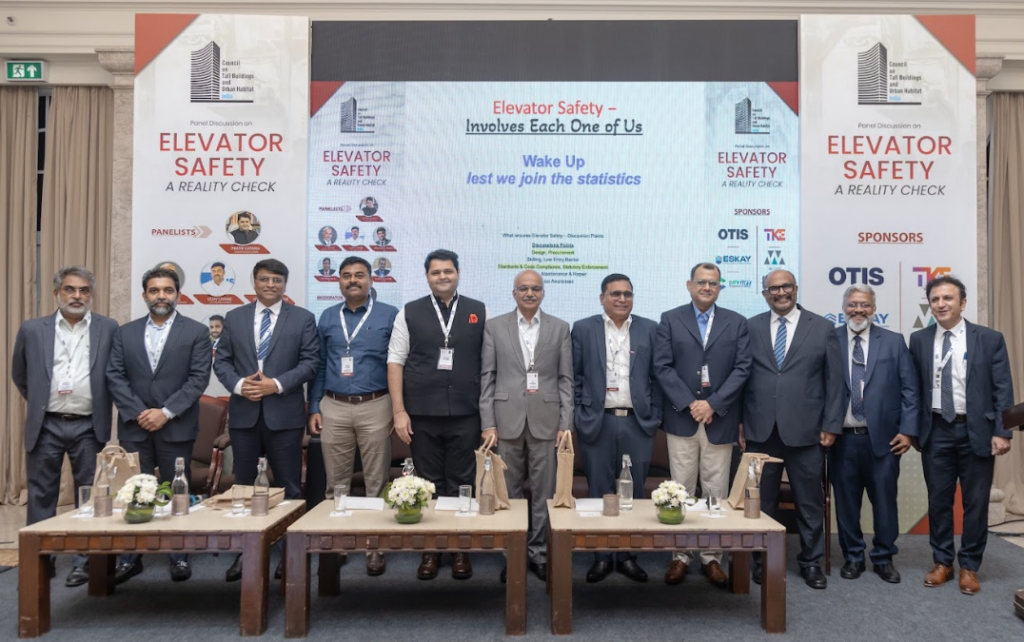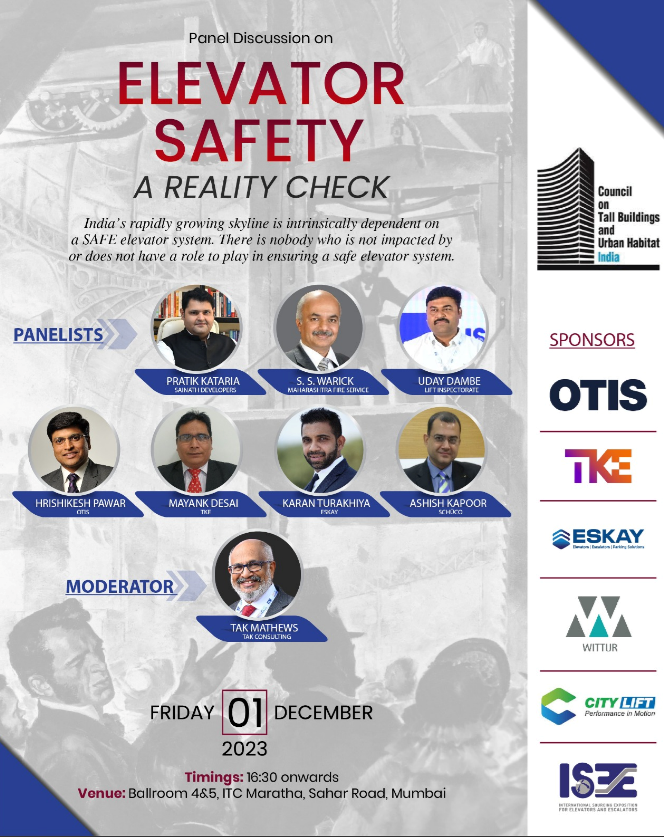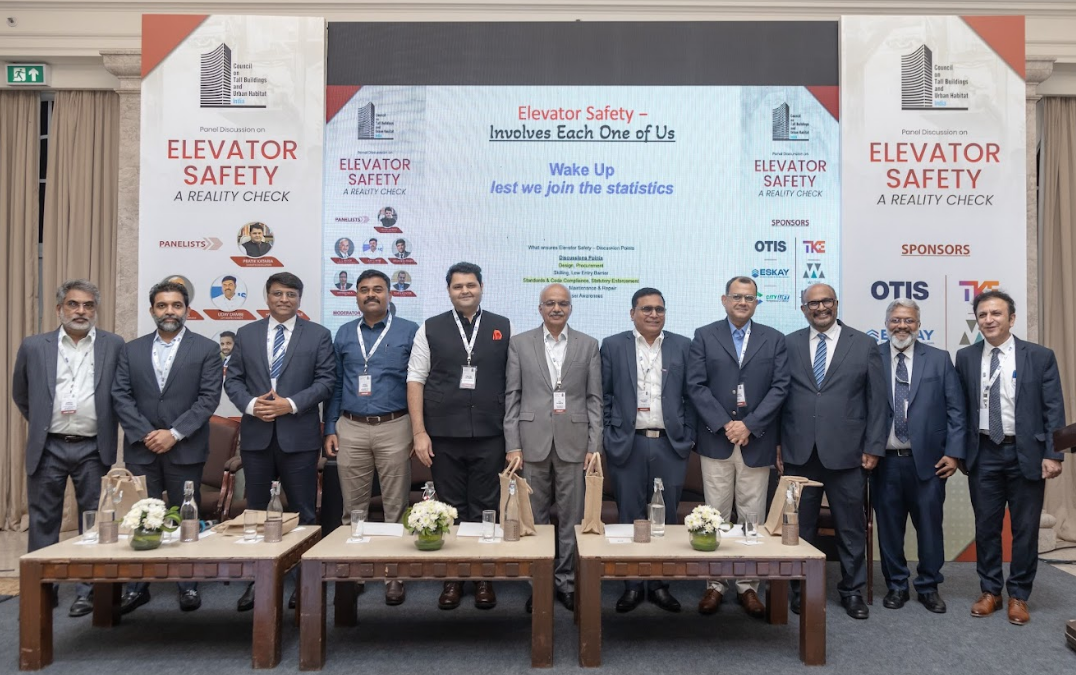Council for Tall Building and Urban Habitat- India Chapter held a Panel Discussion on Elevator Safety- A Reality Check on December 1, 2023 in Mumbai.
The panelists comprised Pratik Kataria- NAREDCO Nexgen, Uday Dambe -Lift Inspectorate, S S Warick- Directorate of Fire Services, Maharashtra, Hrishikesh Pawar- Otis Elevators, Mayank Desai- TK Elevators, Karan Turakhiya- Eskay Elevators and Ashish Kapoor- Shuco. The event was sponsored by Otis Elevator Company, TK Elevator, Esky Elevators, Witter Elevator Components, City Lifts and ISEE.
The event began with the introductory address by Girish Dravid, Chairman- CTBUH India. This was followed by presentations by sponsors Otis and TKE. Karan Turakhiya of Eskay Elevators spoke on the anomaly of reducing elevator cost and voicing concern over the reducing equipment life cycle in the elevator industry.
In his keynote address Amit Gossain, President – Indian Electrical and Electronics Manufacturers’ Association (IEEMA) Elevator Division, spoke on the need to have a uniform Lift Act in the entire country. As on date only 12 states have a prescribed lift code. He also spoke on the need to upgrade the Indian standards on par with international standards.

Referencing Elisha Graves Otis’ demonstration- “All safe Gentlemen” at the Crystal Palace Exposition of 1953, moderator- TAK Mathews opened the discussion with the remark that the elevator industry was founded on the commitment of safety. He also mentioned that the basic concept of the safety governor has not changed from then to now.
One of the points brought forward by the panel was that, while façade and MEP have, over the last few years, been accorded a fair share of importance while designing tall buildings in India- the same is not true for elevators. VT is not considered critical and finds no place in the design basis of a large proportion of tall buildings in India. A glaring example of this is that the High-Rise Committee, Mumbai that regulates tall buildings has no pre-requisites for elevators! This is alarming considering that VT inadequacy usually cannot be corrected without bringing down the building.
Uday Dambe of Lift Inspectorate clarified that this is a major lacuna in the governing rules and this is now sought to be corrected. He also highlighted a peculiar problem in Mumbai of slum rehabilitation buildings where a portion newly constructed apartments belongs to the existing tenants and cannot be sold. In such buildings, the lack of governing rules coupled with the attempt by the real estate firm’s focus on profitability leads to severe under-elevatoring. This leads to a situation where the elevator cannot even be made available for service during regular hours as passenger traffic keeps building up. Service quality declines, passengers get more frustrated and sometimes they react by damaging the equipment. All this just goes on to compound the problem. Poor design also leads to insufficient pit, headroom or machine room space comprising safe access to the equipment for servicing.
The discussion went on to address the fallacy of falling elevator prices. While an attempt is made to attribute this to more efficient use of technology – in many cases this is achieved by compromising quality in the face of cut-throat competition. Over the years the life-cycle of elevators has come down from 25-30 years to 15-20 years. This has an adverse impact on sustainability. There was also a discussion on the Safety Norms for Existing Elevators which are already incorporated in the Indian Standard.
Another issue of concern is construction elevators which are not covered by any codes. There is urgent need to bring these under the purview of the codes and standards.
The discussion then moved to safe usage of elevators. Hrishikesh Pawar spoke of Otis’s efforts in supporting the Elevator and Escalator Safety Trust in creating awareness on the safe use of elevators and escalators and dos and don’ts to be followed by users.
Pratik Kataria summed up the discussion by saying that we need to change the eco-system so that all stake-holders- the architects and real estate developers, the E&E industry, the regulatory authorities come together to ensure that elevators live up to the original commitment of “All safe Gentlemen”.
In the closing address, Suraj Thodimarath, President- Elevator and Escalator Manufacturers’ Association of India (EECMAI) spoke on how EECMAI was formed as a coming together of like-minded individuals as a part of the ‘Atmanirbhar’ India campaign to produce components that could compete with the best in the world. He concluded by reiterating EECMAI’s commitment to promoting quality and safety among component manufacturers in India.

